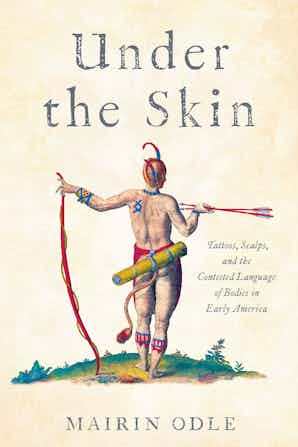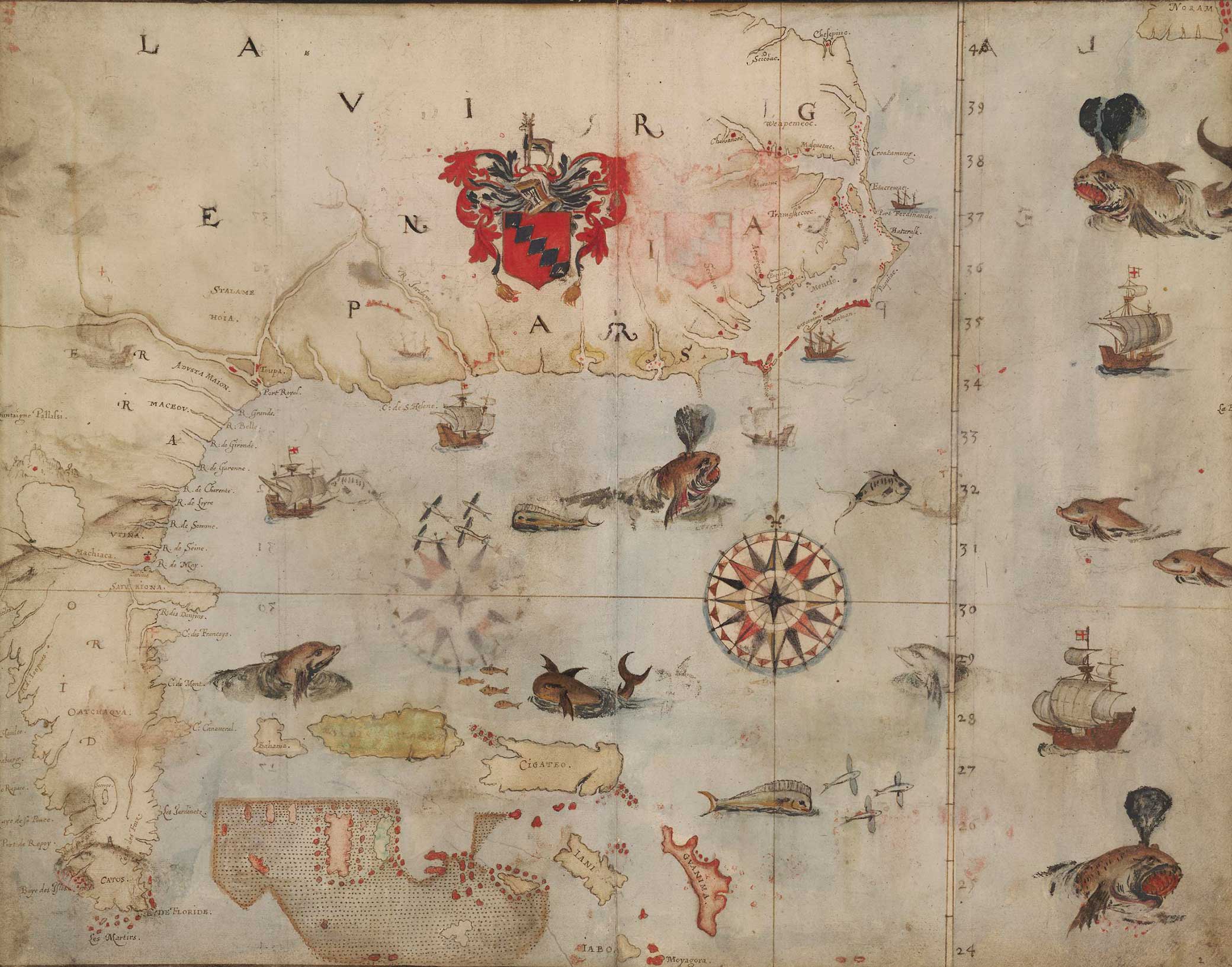
Map of the East Coast of North America, by John White, c. 1585. © The Trustees of the British Museum.
In the watercolor, a woman stands with one foot hooked behind the other leg, her arms curved upward over her chest, hands resting on her shoulders. She gazes outward at the viewer, parallel dotted lines extending along her cheekbones, three vertical lines on her chin. A dark “V” in the center of her forehead and geometric bands encircling her bicep and calves complete her detailed tattoos. In addition to these marks, she is dressed simply in a fringed, knee-length skirt made of skin and a blue beaded necklace. The painter did not record this woman’s name, labeling the piece “One of the wives of Wyngyno”—one of the wives of Wingina, the chief ruler of the island of Roanoke.
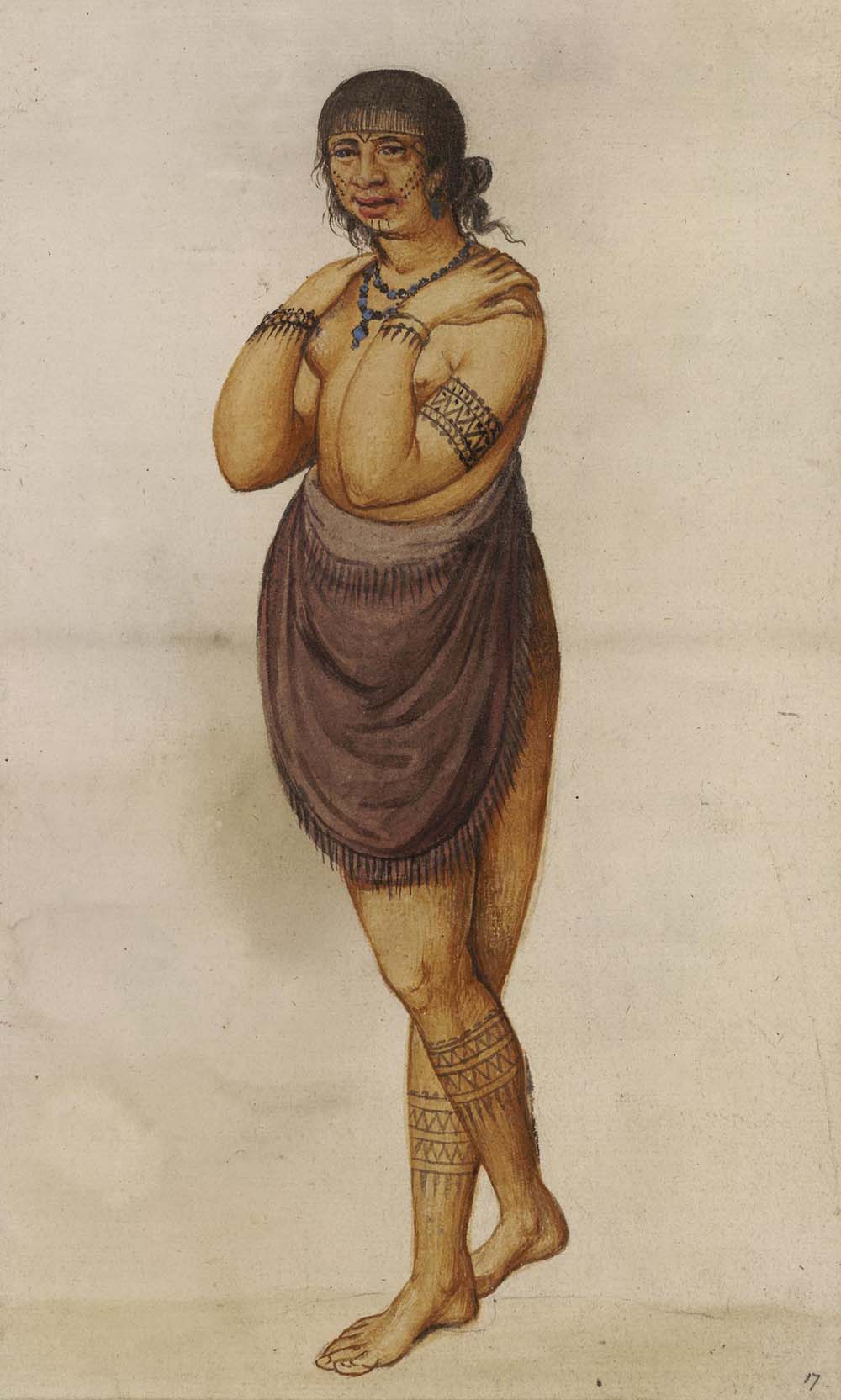
The watercolorist, an Englishman named John White, wrote no other information about the sitter or her appearance. His title for the painting reflected his own society’s assumptions about gender and status, describing the woman solely through her relationship to an elite man. But for all that White failed to see, what he chose to record was also significant. This portrait, along with others made during the same journey, would be closely studied by many in England and be the inspiration for copies viewed widely throughout Europe. As viewers attempted to read the physical appearance of Native Americans, some focused on what they perceived as the “writerly” nature of tattoos, attempting to decipher the messages such marks might carry and questioning what tattooing said about the individuals and societies that practiced it.
In July 1585 John White stood aboard a ship named the Tyger and watched the coast of North America edge over the horizon. He had accompanied a similar voyage the previous year, but this time he had an additional reason to closely observe the landscape. He, along with several other members of the expedition, had been given specific orders to document crucial information about the plants, animals, landscapes, and people they might encounter. As gentleman-limner (or watercolor painter) for the voyage, White was expected to assist in mapping both the unfamiliar American terrain and the unfamiliar appearance of its people.
He was joined by Thomas Harriot, mathematician, scientist, and scholarly polymath, who was charged with learning and translating local languages as well as writing an account of the region’s natural history and its cultures. Harriot’s account, published a few years later under the title A Brief and True Report of the New Found Land of Virginia, was meant both as a report for the voyage’s sponsors and as an advertisement for potential investors in future colonial efforts. The exploratory expedition, under the sponsorship of Sir Walter Raleigh, made landfall in the Outer Banks of what is now known as North Carolina—a land known to its native Algonquian communities as Ossomocomuck.
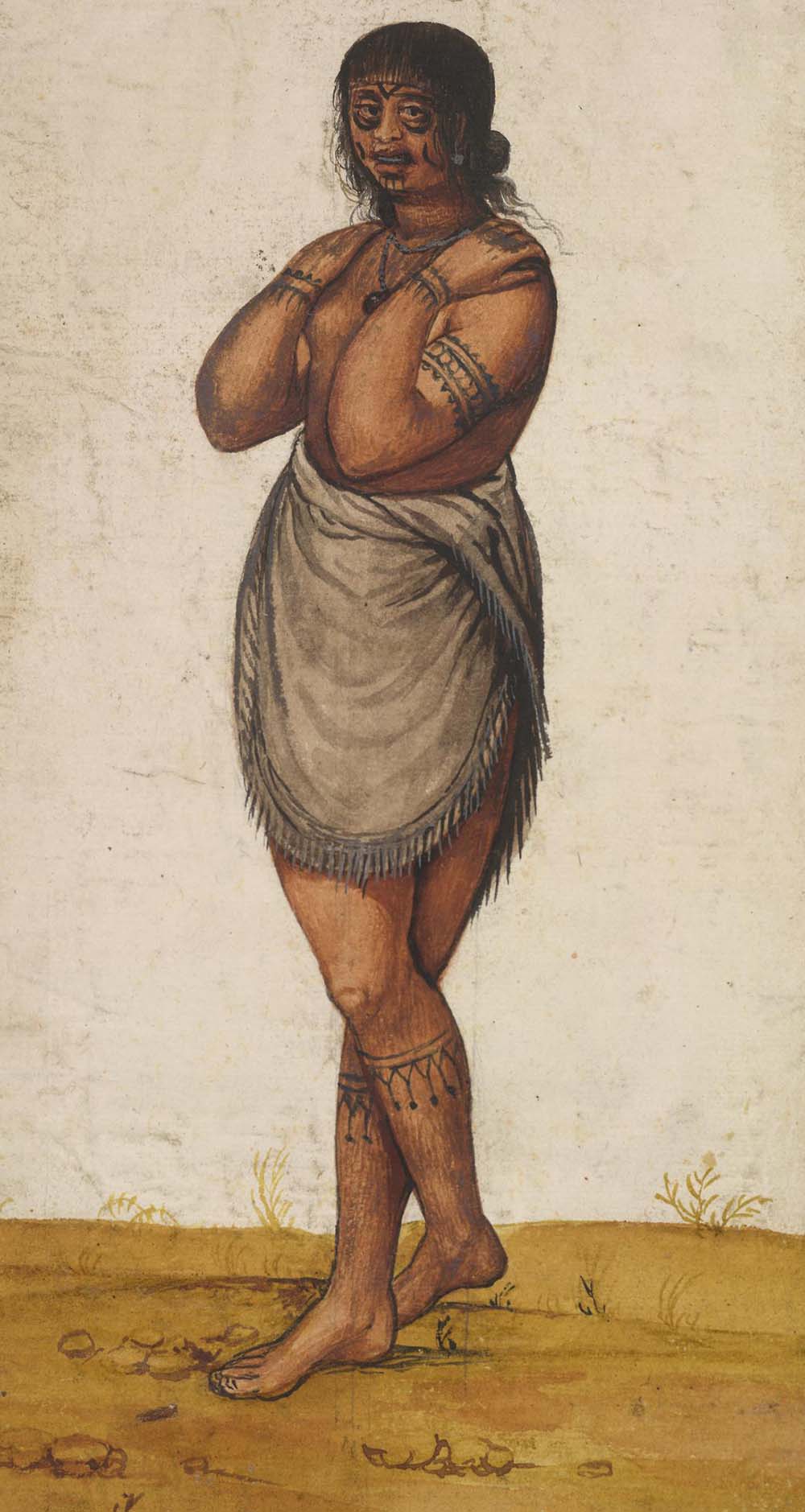
Several years later, Harriot described the expedition’s arrival: “We came unto a good big island, the inhabitants thereof as soon as they saw us began to make a great and horrible cry, as people which never before had seen men appareled like us…such was our arrival into the part of the world which we call Virginia, the stature of body of which people, their attire, and manner of living…I will particularly declare unto you.” Harriot’s words, like White’s paintings, were tasked with describing the bodies of newly encountered people and exploring the significance of physical appearance in cross-cultural settings. In their drawings and descriptions of Native tattoos, the chroniclers of this English expedition attempted to translate such markings and explore their limits as a communication system. English attention to Algonquian tattoos demonstrates that early English colonists did not see the Native societies of the Americas as exclusively oral cultures but rather as possessing complex media forms that they saw as analogous but not equivalent to their own writing. Such efforts to find and ascribe legibility could also function as a means of making people and places easier to colonize.
During such cross-cultural encounters, the outward appearances of new peoples attracted careful scrutiny. Judgments about the intentions, capabilities, and cultures of strangers started at the surface of their bodies. For early modern Europeans, observations of people were as much a form of navigation as observations of wind and ocean currents might be: both were means of understanding where exactly one was in the world. Travelers were urged to make systematic observations, writing, drawing, and collecting samples where possible. John White was expected to create maps of coasts and towns, paintings of animals and plants, and portraits of newly encountered people. While White’s exact orders no longer exist in the record, the directions given to the artist and surveyor for a proposed 1582 expedition, Thomas Bavin, were likely similar. His instructions requested that Bavin draw, among other things, “the figures and shapes on men and woman in their apparel as also their manner of weapons in every place as you shall find them differing.”
Given the space limitations and expenses faced by early exploratory voyages, the inclusion of an artist might seem like a luxury. But artists were crucial for recording information that was more clearly documented in images than in writing, particularly the costuming and appearance of foreign bodies. Such depictions also enabled firsthand interpersonal encounters to be interpreted and shared with those at a distance. Face-to-face embodied readings, potentially intense in affect, could thereby be translated—and moderated—and thus conveyed to others with no immediate knowledge of new peoples through books, artwork, or spoken accounts.
In early modern Europe, these aspects of appearance that could be manipulated were often held to provide valuable insights into the culture and social status of their bearers—perhaps more so than bodily characteristics that might be innate. Clothing and body modifications (whether temporary or permanent) showed what people valued enough to change and how they wished to be perceived by others. Such elements also seemed to require the most translation. Particularly during initial meetings, when spoken communication seemed difficult or impossible, appearance and gesture provided much of the available knowledge. At the same time, because items such as clothing and hairstyles could be modified, there was always the possibility that physical appearance could be deliberately manipulated to deceive observers, making accurate observations and analysis crucial.
In Native America, similar attentiveness was paid to the crucial information supplied by the dress and body modifications of strangers. The Carolina Algonquian communities who met John White and the other Englishmen on the 1585 voyage would have carefully examined their hairstyles (devoid of the asymmetrical scalp locks and topknots their own adult men usually wore), their pox scars (which Native people would soon, devastatingly, acquire), their jewelry and attire. Their interest in colonists’ clothing was apparent in one early miscommunication. During their efforts at human and geographic mapping, members of the Philip Amadas and Arthur Barlowe voyage of 1584 had reported that the land was called Wingandacoa. But a few years later, in an updated interpretation, Sir Walter Raleigh reported that “when some of my people asked the name of that country, one of the Salvages answered Wingandacon, which is to say, as you wear good clothes, or gay clothes.” Arthur Barlowe had also noticed Native interest in his crew members’ bodies, which he imputed to differences in skin tone: “They wondered marvelously when we were amongst them at the whiteness of our skins, ever coveting to touch our breasts, and to view the same.” What Barlowe understood as wonder at “whiteness” may have been an investigation of English bodies for identifying marks, with Algonquians looking for information that could be concealed by European clothing.
Special scrutiny was given to permanent body modifications that decorated the skin: what Bavin’s orders had called “the figures and shapes on men and woman.” Such marks required commitment, signaling something important enough that physical pain and changing one’s appearance forever was worth it. They were also cultural emblems, “consciously assumed markers” of self-presentation, that seemed harder to falsify or misrepresent than jewelry that might be taken off or paint that might be washed away. Attempting to learn what such bodily signs communicated was a pressing concern for both newcomers and natives, as urgent as learning a stranger’s “manner of weapons.”
The mapping efforts of cross-cultural encounters could be considered a process of translation on several levels—not just efforts to learn what others were saying but also attempts to make the unfamiliar legible and manageable within one’s own cultural norms. Issues of language and translation function as metaphors for the broader processes of colonization, mapping new places and peoples into familiar categories. Controlling language and even defining its forms acted as crucial parts of the contest for linguistic, cultural, and political power in early America.
Early North American encounters between colonizing groups and Native Americans were therefore negotiated via an embodied form of reading, and one of the most visible sign systems available for such translation was tattooing. Tattoos have historically been a widespread practice in Native North American societies, performing a range of symbolically powerful, communicative work within and between human communities, as well as with other-than-human persons or supernatural beings. Tattoos traditionally enacted a range of cultural work both through the chosen iconography and the act of tattooing, which took ritualized form in both religious and secular ceremonies. The functions of tattooing have varied widely among Native American societies, from signaling military honors and marking life stages to accessing sacred power, communicating with other-than-human persons, and enabling the performance of gender roles. While direct archaeological evidence for tattooing in the coastal Carolinas has been difficult to trace, a number of items found in sites across the Southeast are thought to be parts of tattooing bundles: needles, pigment, scrapers and paddles, even stamps to apply imagery. Human figurines at several sites show ornamentation analogous to the tattooing depicted on members of southeastern Native groups in early European sources. Tattoos by their very nature, as some anthropologists have argued, demand to be read, particularly by those outside of the bearer’s circle of close family and friends. Alfred Gell writes that tattooing “is always a registration of an external social milieu,” noting that “style in self-presentation presupposes a degree of intersubjective ‘otherness’ which is equally inconsistent with solitude, and with a social universe constituted wholly of intimates.”
Tattooing therefore became a locus for conversations among and between European and Native societies about language, communication, and meaning. As a communication system written on and carried within the body, tattooing concretely linked early modern efforts to interpret body modifications and to translate unfamiliar languages or scripts, while complicating emergent European discourses of text and image as a complementary but distinct binary. The term tattoo did not enter European lexicons until the late eighteenth century; much of the seeming invisibility of early modern tattooing has less to do with a lack of source material and more with the plentitude of terms used to describe it. Many of the words used in English-language accounts were metaphors derived from other practices, including the preparation of parchment for script; the cutting, embroidering, and crafting of cloth; and the stamping or branding of goods, animals, and people. Notable, however, is the lack of a single unambiguous term for the practice, further emphasizing that within colonizers’ communication systems, tattoos called for both text and image to describe what a tattoo appeared to convey to Native Americans in a single mark. Neither text nor image alone seemed sufficient to convey the full complexity of a tattoo in colonial accounts, raising the question for some observers as to whether their own communication systems were insufficient or flawed. The paintings made by John White, the writings produced by Thomas Harriot, and the subsequent texts and images deriving from and building on their proto-ethnographic observations all grappled with the significance of the tattoos on Native people, hoping to acquire reading knowledge of these bodily manuscripts.
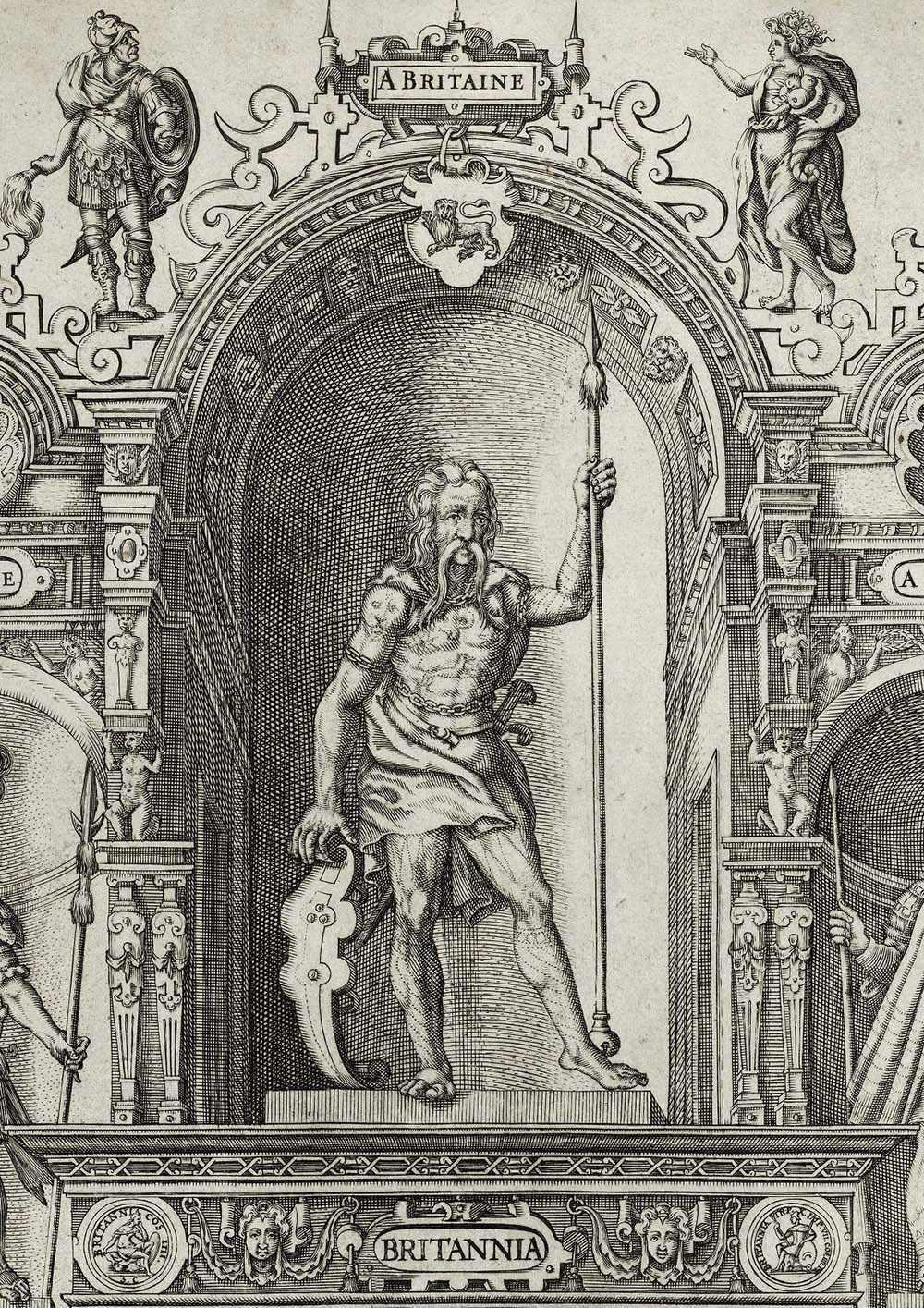
Part of the power of tattooing in these cross-cultural conversations derived from the fact that it was not new to the English, despite their lack of a single term for the practice. The British Isles had their own history of tattooing as well as previous experiences with foreign captives and travelers who had such marks. Indeed, White’s and Harriot’s interactions with the Algonquian communities of Ossomocomuck were likely not their first encounters with tattooed people of the Americas. Less than a decade previously, English expeditions to the Arctic led by Martin Frobisher had kidnapped at least four Inuit with hopes of using them as interpreters and with the intention of displaying them to important patrons. John White painted portraits of these captives, images that were included in the same bound volume as his watercolors of Algonquians. A tattooed Inuk woman known as “Arnaq”—a term likely meaning “woman” rather than her true name—died shortly after Frobisher’s return to Bristol in the fall of 1577, but not before White and at least one other artist, Cornelis Ketel, had painted her and her infant child. Her facial tattoos, which included blue dots across her cheeks and lines on her chin, also prompted written commentary from English scholars. William Camden would later describe the Inuit as having “black hair, broad faces, flat noses…the women painted about the eyes and balls of the cheek with a blue color like that of the ancient Britons.” Familiarity with captives like Arnaq would have primed White, Harriot, and other English observers to expect tattooing on Native Americans and to interpret such markings in light of their own national histories (“like that of the ancient Britons”) and their own expectations about the ways that bodies might tell stories.
Excerpted from Under the Skin: Tattoos, Scalps, and the Contested Language of Bodies in Early America by Mairin Odle. Copyright © 2023 University of Pennsylvania Press. Excerpted with permission of the University of Pennsylvania Press.
